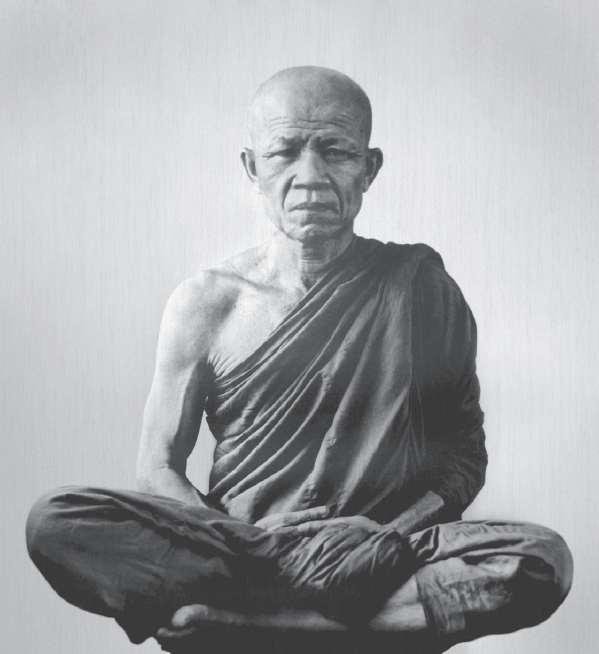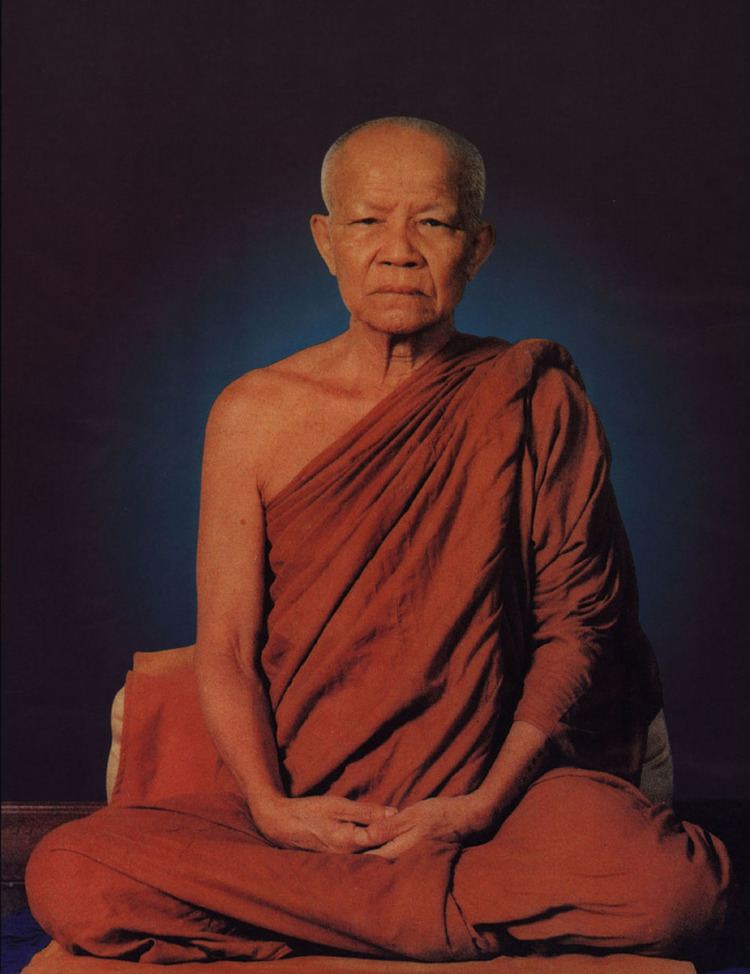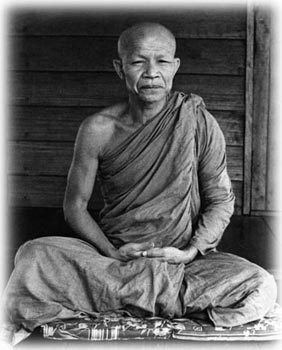Based in Wat Pa Ban Tat Name Ajahn Bua | Dharma names Nanasampanno | |
 | ||
Other names Ajahn Maha BuaAjahn Maha BoowaLuang Ta Maha Boowa Books Venerable Acariya Mun Bhuridatta Thera: A Spiritual Biography | ||
Ajahn maha bua 1 www theravada dhamma org
Phra Dharma Visuddhi Mangala (Bua Ñāṇasampaṇṇo) (RTGS: Phra Thamma Wisutthi Mongkhon (Bua Yanasampanno); Thai: พระธรรมวิสุทธิมงคล (บัว ญาณสมฺปนฺโน)), commonly known as Ajahn Maha Bua or in Thai Luang Ta Maha Bua (Thai: พระอาจารย์มหาบัว, หลวงตามหาบัว; the word "Ajahn" (Thai: อาจารย์; rtgs: Achan) means "teacher"), born as Bua Lohitdee (Thai: บัว โลหิตดี), (August 12, 1913 – January 30, 2011), was a Thai Buddhist monk. Bua is one of the best known Thai Buddhist monks of the late 20th and early 21st centuries. He was widely regarded as an Arahant — a living Buddhist saint. He was a disciple of the esteemed forest master Ajahn Mun Bhuridatta, and was himself considered a master in the Thai Forest Tradition.
Contents
- Ajahn maha bua 1 www theravada dhamma org
- Ajahn maha boowa weeps with pity for us all
- Early years
- Venerable Ajahn Mun
- Seclusion and establishing a monastery
- Wat Pa Ban Taad
- Rise to fame
- Some basic teachings on the Citta
- Kammatthana
- References

Ajahn maha boowa weeps with pity for us all
Early years

Bua was born in Baan Taad village in the northeastern province of Udon Thani. He was one of 16 children of a rich family of rice farmers. When he was 21, his parents asked him to enter the monkhood for a season, a Thai tradition to show gratitude towards one's parents. He entered Yothanimit monastery and was ordained on May 12, 1934, with Venerable Chao Khun Dhammachedi as his preceptor. His preceptor gave him the Pali name 'Nanasampanno', meaning 'one endowed with wisdom'. At the time, Bua had no intention of remaining a monk for the rest of his life.

As Phra Nanasampanno, he studied the incarnations of the Buddha and his Arahant Disciples. He has said he was so impressed that he decided to seek the same enlightenment as had the Buddha's original disciples. He tried to understand the ways of practicing the Dhamma (Dharma) which would eventually lead to Nibbana (Nirvana).
He studied Pali, the language of the Theravada Buddhist scriptures, as well as the Vinaya (the monastic rules of correct conduct). After seven years, he passed the third level of Pali studies, and achieved the highest level in Dhamma and Vinaya studies. He then concentrated entirely on the practice of Dhamma in hopes of studying with Venerable Ajahn Mun, one of the most renowned meditation masters of his time.
Venerable Ajahn Mun
Nanasampanno then went in search of Venerable Ajahn Mun. When he finally met him, he was pleased with his efforts, since it seemed as if Mun already knew his desires, intentions, and doubts. Mun clarified the questions in his mind and showed him the paths leading to Nibbana still exist. Nanasampanno said to himself:

"Now, I have come to the real thing. He has made everything clear and I no longer have doubts. It is now up to me to be true or otherwise. I'm determined to be true!"

He learned the meditation methods followed by Mun, based on the principles of Buddhism and the code of Buddhist discipline. He continued to follow these methods in his own teaching of monks and novices. Due to his deep respect and admiration for Mun, whom he likens to a father and mother to his students, he was inspired to write a biography of Mun to disseminate his methods of practice and document his character for coming generations. He has also written 'Wisdom develops samadhi' and "Patipada' His transcribed talks he gave to laypeople and monks have formed several hundred books in Thai language, but only a few of his talks have been translated into English.Here you can find all his books in English He solely focuses on the practice of Buddhist meditation and has only one aim for his disciples: Reaching the end of dukkha. Several hundred of talks given to his monk disciples were recorded and several thousand of talks given to laypeople, normally after the meal or in the evening were also recorded. The vast amount of recordings can be accessed here: His Dhammatalks in Thai He allowed them to be recorded, so that his fellow practitioners may have a guide in the practice of meditation.
Seclusion and establishing a monastery

In 1950, after the death of Mun, Bua sought a secluded place. He went to Huey Sai village in Mukdahan province. He was very strict and serious in teaching the monks and novices, both in the austere dhutanga practices and in meditation. He continued his teaching until these same principles became established amongst his followers.

Learning that his mother was ill, he returned home to look after her. Villagers and relatives requested that he settle permanently in the forest south of the village and no longer wander in the manner of a forest monk. As his mother was very old and that it was appropriate for him to look after her, he accepted the offer. With a donation of 64 acres (26 ha) of land, he began to build his monastery in November 1955. It was given the name Wat Pa Baan Taad.
Wat Pa Ban Taad
Bua said:
"This monastery has always been a place for meditation. Since the beginning it has been a place solely for developing the mind. I haven't let any other work disturb the place. If there are things which must be done, I've made it a rule that they take up no more time than is absolutely necessary. The reason for this is that, in the eyes of the world and the Dhamma, this is a meditation temple. We're meditation monks. The work of the meditation monk was handed over to him on the day of his ordination by his Preceptor — in all its completeness. This is his real work, and it was taught in a form suitable for the small amount of time available during the ordination ceremony — five meditation objects to be memorized in forward and reverse order — and after that it's up to each individual to expand on them and develop them to whatever degree of breadth or subtlety he is able to. In the beginning the work of a monk is given simply as: Kesa — hair of the head, Loma — hair of the body, Nakha — nails, Danta — teeth, Taco — the skin which enwraps the body. This is the true work for those monks who practice according to the principles of Dhamma as were taught by the Lord Buddha."
The wilderness surrounding the monastery has vanished, as it has now been cleared for cultivation. The forest inside the monastery is all that remains. Wat Pa Baan Taad preserves this remnant in its original condition, so that monks, novices, and lay people can use its tranquility for the practice of the Dhamma as taught by the Lord Buddha.
Rise to fame
Bua has traveled to London to give lectures. He also founded the Help Thai Nation Project, a charitable effort dedicated to helping the Thai economy. He has been visited and supported by the King and Queen of Thailand.
Bua's biographer wrote:
"Ven. Ajahn Maha Bua is well known for the fluency and skill of his Dhamma talks, and their direct and dynamic approach. They obviously reflect his own attitude and the way he personally practiced Dhamma. This is best exemplified in the Dhamma talks he gives to those who go to meditate at Wat Pa Bahn Tahd. Such talks usually take place in the cool of the evening, with lamps lit and the only sound being the insects and cicadas in the surrounding jungle. He often begins the Dhamma talk with a few moments of stillness — this is the most preparation he needs — and then quietly begins the Dhamma exposition. As the theme naturally develops, the pace quickens and those listening increasingly feel its strength and depth."
Some basic teachings on the 'Citta'
Bua observes the essential enduring truth of the sentient being as constituted of the indestructible reality of the citta (heart/mind), which is characterized by the attribute of Awareness or Knowingness. This citta, which is intrinsically bright, clear, and Aware, gets superficially tangled up in samsara but ultimately cannot be destroyed by any samsaric phenomenon. Although Bua is often at pains to emphasise the need for meditation upon the non-Self (anatta), he also points out that the citta, while getting caught up in the vortex of conditioned phenomena, is not subject to destruction as are those things which are impermanent, suffering, and non-Self (anicca, dukkha, anatta). The citta is ultimately not beholden to these laws of conditioned existence. The citta is bright, radiant, and deathless, and is its own independent reality:
'Being intrinsically bright and clear, the citta is always ready to make contact with everything of every nature. Although all conditioned phenomena without exception are governed by the three universal laws of anicca, dukkha, and anattã, the citta’s true nature is not subject to these laws. The citta is conditioned by anicca, dukkha, and anattã only because things that are subject to these laws come spinning in to become involved with the citta and so cause it to spin along with them. However, though it spins in unison with conditioned phenomena, the citta never disintegrates or falls apart. It spins following the influence of those forces which have the power to make it spin, but the true power of the citta’s own nature is that it knows and does not die. This deathlessness is a quality that lies beyond disintegration. Being beyond disintegration, it also lies beyond the range of anicca, dukkha, and anattã and the universal laws of nature. ....'
The fundamental problem that besets human beings, according to Bua, is that they have taken fake and false things as their true self and lack the necessary power to be their 'own true self'; they allow the wiles and deceits of the mental defilements to generate fear and anxiety in their minds. Fear and anxiety are not inherent within the citta; in fact, the citta is ultimately beyond all such things and indeed is beyond time and space. But it needs to be cleansed of its inner defilements (the kilesas) before that truth can be realised. Bua states:
‘Our real problem, our one fundamental problem—which is also the citta’s fundamental problem—is that we lack the power needed to be our own true self. Instead, we have always taken counterfeit things to be the essence of who we really are, so that the citta’s behavior is never in harmony with its true nature. Rather, it expresses itself through the kilesas’ cunning deceits, which cause it to feel anxious and frightened of virtually everything ... As a result, the citta is forever full of worries and fears. And although fear and worry are not intrinsic to the citta, they still manage to produce apprehension there. When the citta has been cleansed so that it is absolutely pure and free of all involvement, only then will we see a citta devoid of all fear. Then, neither fear nor courage appear, only the citta’s true nature, existing naturally alone on its own, forever independent of time and space. Only that appears—nothing else. This is the genuine citta’.
Bua goes on to attempt to describe the inner stages and experience of the cleansed citta. When its purgation of defilements is complete, it itself does not disappear – only the impermanent, suffering, and the non-Self disappear. The citta remains, experientially abiding in its own firm foundation, yet ultimately indescribable:
‘Once the Citta has become so well-cleansed that it is always bright and clear, then ... even though the citta has not ‘converged’ in samãdhi, the focal point of its awareness is so exceedingly delicate and refined as to be indescribable. This subtle awareness manifests as a radiance that extends forth in all directions around us. We are unconscious of sights, sounds, odors, tastes, and tactile sensations, despite the fact that the citta has not entered samãdhi. Instead, it is actually experiencing its own firm foundation, the very basis of the citta that has been well-cleansed to the point where a mesmerizing, majestic quality of knowing is its most prominent feature.
‘Seeming to exist independent of the physical body, this kind of extremely refined awareness stands out exclusively within the citta. Due to the subtle and pronounced nature of the citta at this stage, its knowing nature completely predominates. No images or visions appear there at all. It is an awareness that stands out exclusively on its own. This is one aspect of the citta.
‘Another aspect is seen when this well-cleansed citta enters meditative calm, not thinking or imagining anything. Ceasing all activity, all movement, it simply rests for awhile. All thought and imagination within the citta come to a complete halt. This is called “the citta entering a state of total calm.” Then, the citta’s essential knowing nature is all that remains. Except for this very refined awareness—an awareness that seems to blanket the entire cosmos—absolutely nothing else appears... Distance is not a factor. To be precise, the citta is beyond the conditions of time and space, which allows it to blanket everything. Far is like near, for concepts of space do not apply. All that appears is a very refined awareness suffusing everything throughout the entire universe. The whole world seems to be filled by this subtle quality of knowing, as though nothing else exists, though things still exist in the world as they always have. The all-encompassing flow of the citta that has been cleansed of the things that cloud and obscure it, this is the citta’s true power.
'The citta that is absolutely pure is even more difficult to describe. Since it is something that defies definition, I don’t know how I could characterize it. It cannot be expressed in the same way that conventional things in general can be, simply because it is not a conventional phenomenon. It is the sole province of those who have transcended all aspects of conventional reality, and thus realize within themselves that non-conventional nature. For this reason, words cannot describe it.
'Why do we speak of a “Conventional” Citta and an “absolutely pure” citta? Are they actually two different cittas? Not at all. It remains the same citta. When it is controlled by conventional realities, such as kilesas and ãsavas, that is one condition of the citta. But when the faculty of wisdom has scrubbed it clean until this condition has totally disintegrated, the true citta, the true Dhamma, the one that can stand the test, will not disintegrate and disappear along with it. Only the conditions of anicca, dukkha, and anattã, which infiltrate the citta, actually disappear.
'No matter how subtle the kilesas may be, they are still conditioned by anicca, dukkha, and anattã, and therefore, must be conventional phenomena. Once these things have completely disintegrated, the true citta, the one that has transcended conventional reality, becomes fully apparent. This is called the citta’s Absolute Freedom, or the citta’s Absolute Purity. All connections continuing from the citta’s previous condition have been severed forever. Now utterly pure, the citta’s essential knowing nature remains alone on its own....
'Since this refined awareness does not have a point or a center, it is impossible to specifically locate its position. There is only that essential knowing, with absolutely nothing infiltrating it. Although it still exists amid the same khandhas with which it used to intermix, it no longer shares any common characteristics with them. It is a world apart. Only then do we know clearly that the body, the khandhas, and the citta are all distinct and separate realities...'
Some of the notions found here are reminiscent of the Tathagatagarbha tradition — although the latter posits an original, primordial purity to the mind, whereas Bua sees that purity as needing to be established through mental and moral cultivation.
Kammatthana
Kammatthana literally means "basis of work" or "place of work". It describes the contemplation of certain meditation themes used by a meditating monk so the forces of defilement (kilesa), craving (tanha), and ignorance (avijja) may be uprooted from the mind. Although kammatthana can be found in many meditation-related subjects, the term is most often used to identify the forest tradition (the Kammatthana tradition) lineage founded by Ajahn Sao Kantasilo Mahathera and his student Ajahn Mun Bhuridatta Mahathera.
